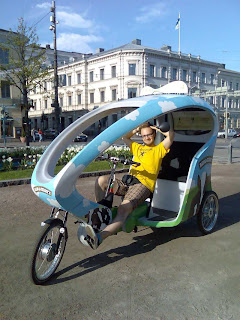Cycling can be the salvation of our cities but only if the implications are accepted that the infrastructure needs to change and restrictions applied to cars. The first costs money and the second clashes with the rights of car drivers. These are high hurdles to leap to make cycling practical and safe. There is also a third less obvious barrier, which can be just as difficult to negotiate: the rights of pedestrians. People on pavements and sidewalks do not like to be at risk of being knocked over by a cyclist. Let us examine the three hurdles of cost, car drivers and pedestrians.
First, money is tight so expenditure on major reconfiguration of the urban infrastructure will not be found easily. We must wait for the normal cycle of urban renewal so that when a new suburb is added, or an area is redeveloped, plans for bicycle provision are included. In these circumstances it is not a question of spending more but of spending differently to put the focus on people: good public transport, walkways and cycleways.
Second, the rights of car drivers should be moved down the policy agenda. This is a loud and powerful lobby but it is the broad rights of people that should be considered. I am a car driver, and I used to be a cyclist until I was knocked down by car and broke my back. The recovery from my injuries was slow and I do not now like to ride my bike on roads shared with cars. I want my rights as a car driver to be curtailed so that so that my right to travel safely by bicycle is restored. I accept that not all car drivers will agree, but if they could visualize how cities could be better it would help to win their support. Examples of high quality cycle provisions are required to bring the vision into observable reality.
Third, pedestrians have to be persuaded that a city that is friendly to cyclists will include spaces that are shared with cyclists. This is particular true in the short-term waiting for the next major redevelopment when the existing space used by both cars and pedestrians has to be reallocated to include space for bicycles. The paths of pedestrians and cyclist will cross; there will be cross words and the occasional bump but hopefully not the same severe injuries that cyclist suffer from cars.
Of the cities that I know well, Helsinki has the best provision for cyclists. It is possible to ride into the city centre from all directions on routes separate from cars. The Finns have planned carefully, invested well and it is understood amongst the city residents that on many routes cyclists and pedestrians share the same space. There is no feeling that the rights of car drivers or pedestrians have been infringed in making cycling easy and safe.
City planners should think bike and face down opposition from car drivers and pedestrians with confidence that people will like the better cities that result. If in doubt, visit Helsinki.

No comments:
Post a Comment